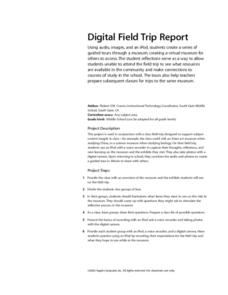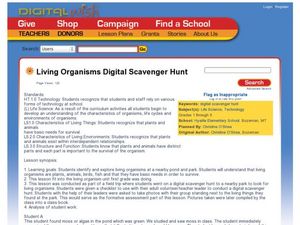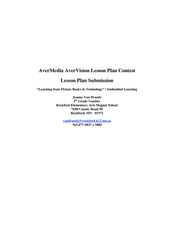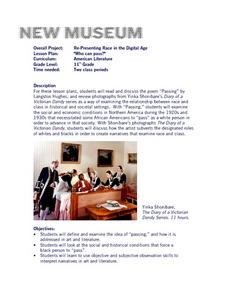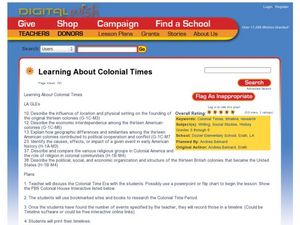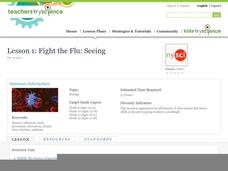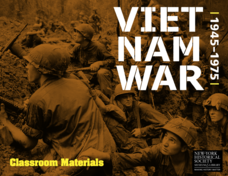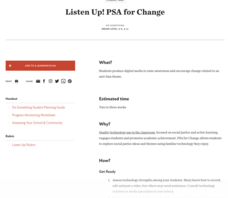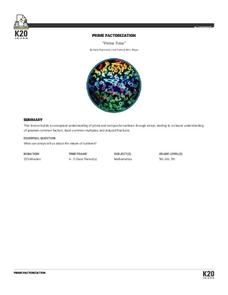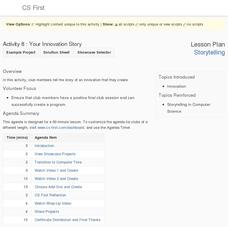Curated OER
What are Numbers?: Learning to Add
Students identify numbers from 0-20. They show quantities to 20. Students work in small groups and take pictures of items demonstrating the numbers that they have beeen taught. They form the number shape using their bodies and take...
Curated OER
Digital Science through Pod Casting
Students create science presentations. In this science unit lesson, middle school students create a presentation on an elementary science concept. The presentations are turned into podcasts for the access of elementary school...
Curated OER
Digital Field Trip Report
Students create a series of guided tours through a museum, creating a virtual museum for others to acess using audio, images, and an iPod. Their reflections serve as a way to allow other students that are unable to attend the field trip...
Curated OER
Living Organisms Digital Scavenger Hunt
Students photograph living organisms. In this plan for a field trip, students go to a local park or pond and photograph themselves with various living organisms on their scavenger hunt list. The photographs taken are compiled into a...
Curated OER
Learning From Picture Books and Technology
Fifth graders complete a demonstration on how to set up, use, and close down a camera. In this technology lesson plan, 5th graders complete the correct sequence and answer questions about camera usage.
Curated OER
Re-Presenting Race in the Digital Age: "Who Can Pass"
Eleventh graders examine the relationship between race and class in historical and societal settings. They read and discuss the poem, "Passing," by Langston Hughes, analyze photographs by Yinka Shonibare, answer discussion questions,...
Curated OER
A Digital Family Tree Trip Through Time
Students research their family history by creating a family tree and using online tools. In this family tree lesson, students use bubbl.us to research their biographical information and web the data. Students create timelines for their...
Curated OER
Data Analysis Digital Display
Students create a survey online. In this math lesson, students graph survey data using flisti.com. They share and analyze their classmates' histogram.
Curated OER
Learning About Colonial Times
Students research Colonial America. In this Colonial Times lesson, students view the PBS Colonial House Interactivewebsite and create a timeline of important events during the Colonial period. Students print and share their timelines.
Alabama Learning Exchange
Learning About Our Government
learners about the organization of our nation's government. They are introduced to the three branches of American government and the responsibilities of each. They discuss the requirements for becoming President.
Curated OER
Painting with and Learning From Art History - Extend the Composition
Students create a painting based on an artist from a chosen period in history. They research a modern artist and write a critique.
Curated OER
Through the Viewfinder: Learning to Think Like a Professional News Photographer
Students investigate the skills for photo composition to become quality photojournalists. In this photojournalism lesson, students cut out photographs from magazines and decide on the best ones, as well as determine what makes them good....
New York City Department of Education
Isabella’s Garden
Create rows and rows of vegetables. Pupils use their knowledge of multiplication to find the number of vegetable shoots planted in a garden and ways to arrange the vegetables in the performance task. Teachers use the suggested unit...
CK-12 Foundation
Estimation of Whole Number Multiplication and Division: Lettuce Garden
Estimating whole number multiplication and division is the focus of an interactive that uses a garden plot with moveable points to answer six questions.
Royal Conservatory of Music
The Anti-bullying Magazine
Get the word out about friendship, support, and a safe school community with a media literacy lesson about bullying. Young journalists investigate instances of bullying and take descriptive pictures as they compile a magazine to fight...
Curated OER
Lesson 1: Fight the Flu: Seeing
The flu has been a deadly epidemic many times in the past. By examining technological innovations throughout history, then simulating the spread of disease from person to person through a classroom investigation, and finishing up with...
NOAA
Biological Oceanographic Investigations – Through Robot Eyes
How can a robot measure the length of something when we don't know how far the camera is from the object? The lesson explains the concept of perspective and many others. Scholars apply this knowledge to judge the length of fish and the...
New York Historical Society
The Vietnam War: 1945-1975
Do pupils know that the Vietnam War spanned a period of 30 years? A war that long is bound to leave devastating effects. Help young historians develop a comprehensive understanding of the war through multiple units on the subject that...
Teaching Tolerance
Listen Up! PSA for Change
Challenge scholars to speak up about a topic by creating a public service announcement or social media blitz about an issue they feel passionate about. Have them research their issues, then decide the best way to take their messages to...
Google
Art: Introduction and Discovery
Art isn't the first thing that comes to mind when thinking about computer science. The first installment of an eight-part Google CS Art unit introduces the series and highlights class procedures. Pupils view videos that show how to use...
International Technology Education Association
Reinventing Time
Take a trip through time. A lesson resource provides instruction on the origin of current measurements for time. The text explains the different tools humans used throughout history to measure time as well as provides examples such as...
Annenberg Foundation
Making an Issue-Based Video
Encourage class members to become engaged citizens by researching an issue they are passionate about and then producing a video to present to policymakers, the public, and their peers. Everything needed for the unit is contained in...
K20 LEARN
Prime Time
How many prime numbers are there between 1 and 100? By using a prime time resource, your scholars should be able to answer this question. Using arrays, they determine if numbers are prime or composite, and then write a prime...
Google
Storytelling: Your Innovation Story
Explore a trailblazing way to talk about innovation. Using the Scratch coding program, young computer scientists create innovations and write stories to accompany them. They include some of the add-ons they mastered throughout the unit.




